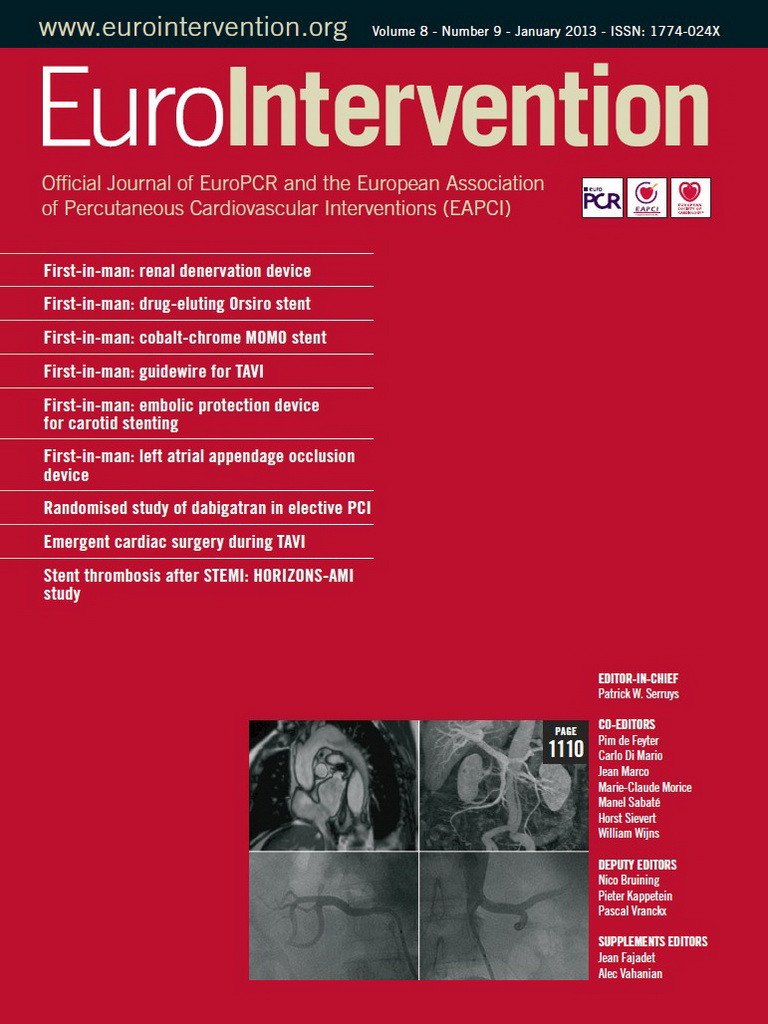Hypertension is a major cardiovascular risk factor, and despite the availability of effective antihypertensive drugs the percentage of patients with blood pressure at target values remains low. Especially patients who cannot be controlled by conventional drug treatment are at increased risk of cardiovascular events, which supports the need for greater efforts toward improving hypertension outcomes in this population1. Recently, catheter-based renal denervation has been introduced into the market as a new and promising technology to reduce sympathetic activity and blood pressure in patients with resistant hypertension2. The first-in man (FIM) study was performed using a radiofrequency-based approach (Symplicity, Ardian/Medtronic, Mountain View, CA, USA) and provided evidence for the concept of renal nerve ablation as an antihypertensive treatment3. Numerous new percutaneous renal nerve ablation systems are currently being tested and will soon be released into the market. Already in 2012 five CE-marked renal denervation systems using different treatment strategies are available: Medtronic’s Symplicity, St. Jude’s EnligHTN, Vessix’s V2, Covidien’s OneShot and Recor’s Paradise. Most of these systems use radiofrequency energy to target renal sympathetic nerves except for the Recor’s Paradise system which uses ultrasound4. Up to now, the largest –albeit in patient numbers still limited– clinical experience with the longest follow-up has been obtained with the Symplicity catheter system.
In this issue of EuroIntervention, Ormiston and colleagues present a first-in-man report of a 75-year-old woman with resistant hypertension who underwent renal denervation using a low-pressure balloon (1 atm) with a mono-polar silver electrode (helical configuration) system (9 Fr), allowing a straightforward radiofrequency ablation. One and six months after the procedure both office and ambulatory5 blood pressure significantly decreased, in line with the reductions reported in trials using other devices. As mentioned by the authors, the patient was treated as part of the Maya Renal Hypertension Ablation System trial (NCT01520506), aimed at investigating the safety and effectiveness of renal denervation in 40 patients with resistant hypertension. However, neither this study on a larger cohort of patients nor preclinical studies in porcine models have been published so far.
In the light of the huge market for renal denervation systems all over the world a word of caution is required. Despite the request to optimise the interventional profile, reduce the treatment time and thereby radiation exposure, all devices, and especially those using new treatment modalities, have to show favourable safety and efficacy profiles in a larger cohort of patients with subsequent follow-up before general use can be recommended. Recently, concerns have been raised that renal denervation might induce renal artery stenosis. Two case reports have been published describing a secondary rise in blood pressure after renal denervation caused by a progression of a renal artery stenosis6,7. It remains unanswered to what extent the ablation procedure and/or the catheter manipulation induced or promoted the rapid development of renal artery stenosis, or whether it represented a natural progression of the disease process. Therefore, clinical data on the long-term vascular safety in a large cohort of patients –for each of the devices– is needed in order definitely to determine the role of renal denervation in antihypertensive therapy.
The interest in renal denervation is rapidly growing and some time soon the interventional cardiologist will, beside the challenges in proper patient selection, also be confronted with questions regarding appropriate device selection: 1) What are the advantages and disadvantages of the available CE-marked devices for catheter-based renal sympathetic denervation? 2) What are the interventional features of these different technologies? 3) Are there major differences in clinical outcomes? 4) How to select the appropriate device for each patient?
As a joint initiative, the European Association of Percutaneous Cardiovascular Interventions (EAPCI), the European Society of Hypertension (ESH) and PCR are organising the first resistant hypertension course on the 15-16th February 2013 in Berlin, Germany. This course has been created in order to provide practical information on the optimal care for resistant hypertensive patients and to reflect on the current state of knowledge in this exciting field. Besides all the technical issues, including those mentioned above, this course will address the various medical aspects of patients who have apparent treatment-resistant hypertension such as secondary hypertension and spurious hypertension and will touch on problems related to drug compliance as well as ambulatory blood pressure measurements.
Conflict of interest statement
F. Mahfoud is supported by Deutsche Hochdruckliga and Deutsche Gesellschaft für Kardiologie, and received speaker honoraria or scientific support for clinical studies from Medtronic, St. Jude Medical, Vessix and Recor. S. Kjeldsen received lecture honoraria for AZ, Bayer, Medtronic, MSD and Takeda and is a consultant for Bayer, Medtronic, Takeda and Serodeus.

